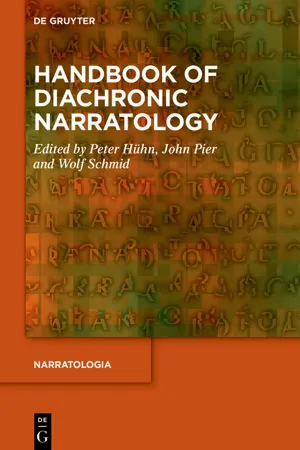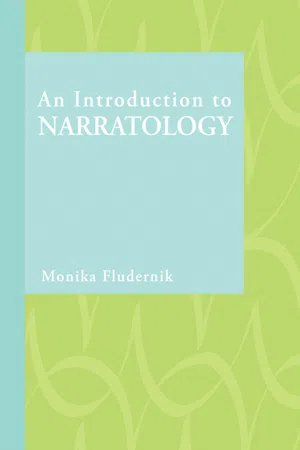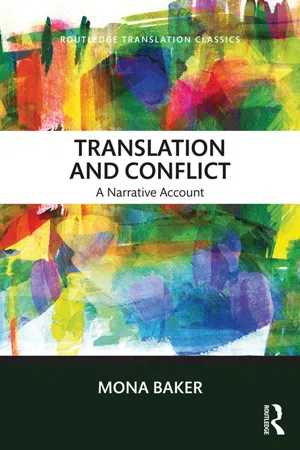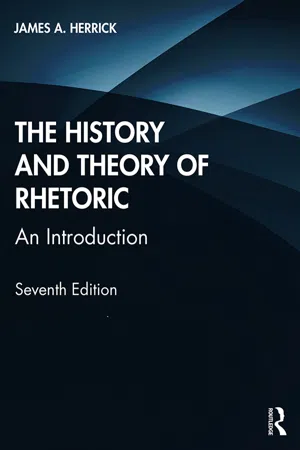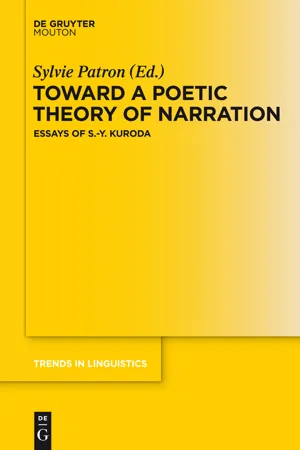Languages & Linguistics
Narration Rhetorical Mode
Narration is a rhetorical mode that involves telling a story or recounting a series of events. It is used to convey information, entertain, or persuade an audience. In narration, the focus is on the sequence of events and the development of characters, setting, and plot.
Written by Perlego with AI-assistance
Related key terms
Related key terms
1 of 4
Related key terms
1 of 3
7 Key excerpts on "Narration Rhetorical Mode"
- eBook - ePub
- Peter Hühn, John Pier, Wolf Schmid, Peter Hühn, John Pier, Wolf Schmid, Peter Hühn, John Pier, Wolf Schmid(Authors)
- 2023(Publication Date)
- De Gruyter(Publisher)
ratio studiorum: the student worked on these exercises during the year prior to the study of rhetoric properly speaking, which was devoted to the Humanities. Thus, on the one hand, narration is a sophisticated syntagmatic device integrated into a larger discursive whole; on the other hand, it is an autonomous piece of writing open to variations that are more or less academic, more or less ingenious. Nowhere, however, is it a composition of facts in a system (as in Aristotle’s famous definition of poetic mimesis). In rhetoric, narration is not an art of the plot; more precisely, it is not an art of linking facts into the intricate whole of a unified plot.So what is narration? The answers to this question offered by traditional rhetoric for fifteen hundred years have remained remarkably stable:-
syntagmatically, narration is a part of discourse that can be broken down into autonomous units; paradigmatically, it is an arrangement of facts;
-
it consists mainly in the circumstances of the fact;
-
it is characterized by brevity, clarity, and verisimilitude;
-
it can be amplified through the use of ornaments.
Summed up in this way, the doctrine of narration does not appear to have much to offer us, either from the angle of the production of narratives or from that of their reception. Yet this doctrine remains absolutely fundamental for understanding the art of narration during the ancien régime: contrary to the tightly wrought plot in Aristotelian poetics, discussed only among scholars and literati, the rhetoric of narration is a cognitive tool that infuses all forms of narrative production and commentary, an elementary grammar of narrative that structures the most immediate intuition as well as the most fine-grained analysis.How is it that the rhetoric of narration came to have such a degree of preponderance? By benefiting from a solid institutional anchoring in education, beginning with elementary education, since the rhetorical grammar of narrative was included in the preparatory program for the class in rhetoric. It was the subject of the first three chapters of preliminary exercises, devoted respectively to the Aesopic fable, or tale with a moral intent; to “narration,” or the short verisimilar story; and to the chreia, or laudatory narrative of a memorable event or saying. These exercises were spread over the first two months of the class in Humanities before going on to a more in-depth treatment during the class in rhetoric properly speaking, which was devoted to learning each part of speech. In both classes, the rhetoric of narration was based on three additional resources: (1) teaching of rules (with the use of treatises), (2) analysis of ancient models (narration in the plays of Terence and in the fables of Phaedra, for instance; for the preliminary exercises, the narrative parts of the major orations of Cicero and of the Latin historians in the rhetoric class), and (3) written composition imitating the ancients. - eBook - ePub
- Monika Fludernik(Author)
- 2009(Publication Date)
- Routledge(Publisher)
7 Language, the Representation of Speech and the Stylistics of NarrativeIn this chapter we shall be looking at the part played by language and traditional stylistic and rhetorical devices in narrative discourse. Scarcely any attention has been paid to this in classical narrative theory. I am primarily concerned with the status of stylistic features in relation to the quasi-universal structures which are generally assumed to underlie narrative texts.Language The linguistic mediumLanguage is by far the most common medium of narrative texts. Novels and plays consist of language, and films or cartoons include a significant percentage of language. Only ballet, mime, and, in rare instances, cartoons are purely visual and dispense with language altogether.It is important to remember that language, as well as being the medium for narrative texts, is also a part of the fictional world created by narratives. Taking this into account, it becomes clear that in drama, film and cartoon, language is not in fact the predominant medium of representation but exists only as one element of the story world (for the moment, I shall not deal with film scripts and play texts). In conversational narrative and in novels and short stories (as well as in poetry), language is both the medium and the object of representation.The role of speech in characterizationTo put this in a different way, in the alternative world of a novel, language is the means by which characters communicate with each other. The narrator, in so far as s/he figures in the story, uses a language of her/his own. It might, in fact, be better to say that precisely because language is used here, we as readers become aware that there are characters and narrators. No language, no characters: even animal protagonists in novels make use of language, otherwise they would lack the essential quality which protagonists in narratives must have – an anthropomorphic existence. - eBook - ePub
Translation and Conflict
A narrative account
- Mona Baker(Author)
- 2018(Publication Date)
- Routledge(Publisher)
Introducing narrative theoryThe notion of narrative has attracted much attention in a wide range of disciplines, and has accordingly been defined in a variety of ways. This chapter will draw primarily on social and communication theory to elaborate a definition of narrative that is particularly suited to investigating the way in which translators and interpreters function in situations of conflict. I start with an overview of the status and effects of narrativity, including its relationship to genres, science, categories, fact and fiction, and conclude with a discussion of the political import of narratives and the way in which narrative both reproduces existing power structures and provides a means of contesting them.2.1 The status and effects of narrativityMany scholars, especially in literary studies and linguistics, tend to treat narrative as an optional mode of communication, often contrasting it with argumentation or exposition. Approaches that treat narrative as an optional mode tend to focus on the internal structure of orally delivered or literary narratives – in terms of phases, episodes and plots, for instance – and to stress the advantages of using narrative, rather than other modes of communication, to secure the audience’s commitment and involvement. The best and most influential example of this tradition is Labov. A very brief summary of his approach might help clarify important differences between literary and linguistic approaches to narrative and the broadly sociological approach adopted in this book.Labov defines narrative as ‘one method of recapitulating past experience by matching a verbal sequence of clauses to the sequence of events which (it is inferred) actually occurred’ (1972: 359–60; emphasis added), and what he calls a ‘minimal narrative ’ as ‘a sequence of two clauses which are temporally ordered - eBook - ePub
Writing Put to the Test
Teaching for the High Stakes Essay
- Amy Benjamin(Author)
- 2013(Publication Date)
- Routledge(Publisher)
IIRhetorical Modes
Passage contains an image
5
Teaching Writing Through Rhetorical Modes
Because much of our understanding of the world comes through the recognition of patterns, it is extremely helpful to understand how writing topics fall into the following major rhetorical modes: ♦ Narration ♦ Description ♦ Cause and effect ♦ Classification and division ♦ Comparison/contrast It should be noted that some writing texts condense these categories onto only four rhetorical modes: narration, description, exposition, and persuasion.Each rhetorical mode accomplishes its own purpose. Each comes with its own structure and language. Most text is organized around a predominant rhetorical mode, supported by at least one secondary mode. For example, narration often partners up with description; definition partners with exemplification.Teaching writing through the rhetorical modes, which are also called discourse modes, goes way back to Aristotle. However, this paradigm for teaching writing lost its place at the table of writing instruction in the 1970s and 1980s when “process pedagogy” came into favor. Actually, there’s no reason why instruction in the rhetorical modes needs to compete with writing process instruction: both can be mutually supportive. The advantage of teaching writing through the rhetorical modes, as we will see, is that once we know what mode we’re in, we can build within an existing structure that we already understand.Karen Gocsik, executive director of the writing program at Dartmouth College, says this about discourse mode pedagogy:[M]odes of discourse instruction can be used to lead students systematically through a hierarchical system of cognitive functions. In these classrooms, professors develop assignments that progress through the modes, moving students from the personal narrative to the analytical argument, and from simple organizational strategies that are chronological and spatial, to more complex organizational strategies that are more formally logical. In this way, modes of discourse instruction sharpen students’ critical and analytical skills. - eBook - ePub
The History and Theory of Rhetoric
An Introduction
- James A. Herrick(Author)
- 2020(Publication Date)
- Routledge(Publisher)
Phaedrus , where Socrates relates stories to argue for a particular view of the human soul (the myth of the charioteer) or to suggest the dangers inherent in moving from oral to written discourse (the myth of the Egyptian god Thoth). Some recent theorists have expanded the concept of narration to the point that it subsumes all of rhetoric, while others have discovered a rhetorical dimension in the writing of all fiction.Changes
In the age of social networking, how does one determine what constitutes a rhetorical text? How can interpretive practices accommodate the difficulty of distinguishing a “source” and an “audience” in fluid and interactive rhetorical settings? How does rhetorical theory, rooted in classical thinking, come to recognize the multiple meanings evident in discourse created by diverse groups? In a new digital era in which video clips and popular songs compete with campaign speeches and editorials, how are the social functions of rhetorical discourse best explained?The practice of rhetoric has changed in recent decades, and some rhetoricians have found in narrative theories the flexible structure necessary to account for new rhetorical forms and functions. Susan Wells, for instance, finds narrative to be “central to the discourses of modernity because of its heterogeneity, its complex articulations of time, and its construction of the narrator’s fluid subject position.”41 Narrative, according to Wells, is “marked by deep diversity of styles, forms of argument, and rhetorical relations,” and offers ways to “organize separate trajectories of knowledge and reflection.”42 - eBook - ePub
- Horst Ruthrof(Author)
- 2016(Publication Date)
- Routledge(Publisher)
Chapter 3 Narrative languageTHE CONCRETE DATUM
‘Narrative,’ Michel Butor tells us, ‘is a phenomenon which extends considerably beyond the scope of literature; it is one of the essential constituents of our understanding of reality. From the time we begin to under stand language until our death, we are perpetually surrounded by narratives, first of all in our family, then at school, then-through our encounter with people and reading.’ (1 ) An even wider conception of narrative is offered by Barbara Hardy in ‘Towards a Poetics of Fiction: An Approach Through Narrative’, the focus of which is on ‘the qualities which fictional narrative shares with the inner and outer story telling that plays a major role in our sleeping and waking lives.’ And her paper makes the further claim that ‘we dream in narrative, daydream in narrative, remember, anticipate, hope, despair, believe, doubt, plan, revise, criticize, construct, gossip, learn, hate, and love by narrative.’ (2 )This widens the discussion about narrative considerably, and I would like to specify some of these issues by first distinguishing ‘narrative’ as a non-literary or literary unit, a closed form, from ‘narrative mode’ as the predominant mode of presentation in narratives as well as in the non-formal inner and outer streams of story telling. As a second qualification, I should point out that there are also non-narrative modes in our mental lives. Do we not some-times slip into the role of a second self in order to defeat the opponent of a past real verbal contest by employing a superior strategy a posteriori? An inner drama is acted out in which we not simply sympathize or try to identify with one of the contestants but are the protagonist. Or, our stream of thought may take on an attitude of praying, total admiration, fear, triumph, or resignation in which the chanting I, the addressed object and the process of addressing appear to melt into one homogeneous whole. This, in accordance with a long-standing literary tradition, I wish to regard as a lyrical mode. - eBook - ePub
- Sylvie Patron(Author)
- 2014(Publication Date)
- De Gruyter Mouton(Publisher)
Chapter 3Reflections on the foundations of narrative theory, from a linguistic point of view 168
1 The communicational theory of narration
1.1
It is a widely held view that language (langage ) is a phenomenon of communication. A specific language as a system of knowledge (langue ) would then be a system of code; each sentence would be a code for a minimum unit of message. An occurrence of a sentence in speech (parole 169 ) would represent a unit message to be communicated by the addressor to the addressee by means of this communication system.A unit message to be represented by a sentence, in this conception of language, is the content of a mental act of judging, wishing, etc. We are not concerned with a systematic taxonomy of the mental acts that underlie such sentence uses in linguistic performance. It suffices for our present purposes to characterize the mental act underlying the use of a sentence as an act of judging or a modification of it in some sense or other. The substantive content of such an act of judging, genuine or modified, is an event, or a state of affairs, real, imagined, wished, etc. For the sake of simplicity of exposition, in what follows I shall in general write as if a sentence used in speech performance in communication is an expression for the content of an act of judging, leaving possible modifications of such acts to be understood implicitly.A theory of language must include both a theory of linguistic performance and a theory of linguistic competence.170
Index pages curate the most relevant extracts from our library of academic textbooks. They’ve been created using an in-house natural language model (NLM), each adding context and meaning to key research topics.
Explore more topic indexes
Explore more topic indexes
1 of 6
Explore more topic indexes
1 of 4
